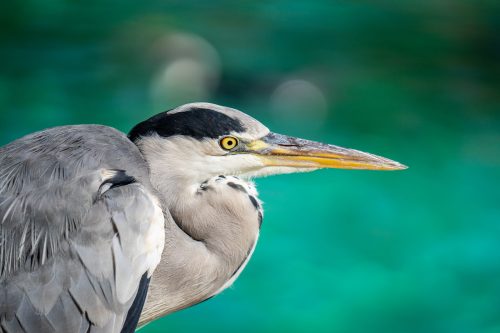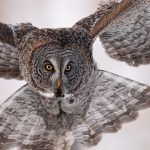A heron is a long-legged bird from a different genus but of the family Ardeidae, and from it arises several species. They are of the kingdom Animalia and from the phylum Chordata. Among the many species of herons, we have the common egret (cattle egret) or bitterns. They in nature symbolize serenity, tranquility, grace, and elegance. They mostly feed on aquatic prey. In addition to the long legs, a heron also has a long S-shaped neck with long beaks. The s shape of the neck is to provide support to the heavy head and bill. They are either white or have decorative plumes.
Their large size is advantageous to them in such a way that they only have very few predators. They are mostly found in freshwater wetlands, ponds, and even lakes. They possess big/large wings and a sharp bill that is as well big. Their long legs are used for or rather assist them in wading through the water. Some parts of their bodies are covered with fine powder. This, together with the disintegrating feathers, enables the bird to clean itself.
Some herons will also attack and eat cats. This behavior is most often seen in young herons who have not yet learned to hunt successfully on their own. Adult herons typically do not attack cats unless they are starving or the cat is particularly small.
. The wingspan is huge and is estimated to be about two times larger than that their actual body size. Both the herons (male and female) participate in taking care of their young ones, and they change their partner every single year. They also fly like any other bird but have an excellent speed of up to about 30 miles per hour.

Will a cat attack a heron?
It is believed that not so many cats would try as much to attack either an egret or a heron. It is very rare to come across such instances. But still, some domestic cats are known to kill smaller birds. However, this is possible because most herons and egrets live in shallow waters along rivers or ponds as they feed on fish. This increases their risk of being attacked by either cats or dogs. To protect the birds from cats, cat owners should keep their cats indoors, and stray or feral cats should not be fed. To protect themselves, herons construct nests for themselves and their hatchlings. They use several sticks in bushes, trees, and cliffs to set up their nests. In this, they will exist as rookeries or heronries. Herons use their long bills to catch fish, small mammals, insects, and amphibians in shallow waters. The long bill can also kill juvenile birds, for example, ducks. When straightened, the bill strikes the neck way too quickly.
Are herons aggressive?
Yes, herons are aggressive, but it is believed that they possess some aggressive behavior only when provoked, for instance, when their young ones are threatened, when they are cornered and when they are handled. Just like any other normal wild creatures, they fear human beings. They have a long, powerful beak that can kill a human being. Getting close to these birds is risky; they have sharp eyesight and are very sensitive to any slight noise and movements. They defend their territories and areas by chasing away other blue herons and threatening displays. It is not safe to handle herons during their rehabilitation. Herons do their hunting mostly at dawn and dusk. This is to avoid being seen by their potential. In case a person gets too near to their nest, they portray a defensive mechanism by flying towards that person. Herons raise their crests like a snake and stab with their heads as a weird part of their unusual aggression. To catch their prey, herons walk slowly at a pace of 60 steps in one minute. Their horns are used to probe and stir, while their feet are used for flushing the prey out. Winds also help the heron in terrifying the pry and minimizing radiance.
To stop herons from perching on rooftops and fence lines, you can choose to install bird deterrents, for instance, bird spiders and bird spikes. To keep them away from ponds, you should consider installing bird netting or a wire grid above the pond.
Can a heron eat a dog?
As much as they are carnivores, they do not eat dogs. This is simply because they do not have beaks to tear down flesh; instead, they swallow their food when whole. They opt to swallow big chunks for prey/ dogs that are big. They are also formidable birds; on rare occasions, they would kill a puppy but not feed on it as it’s way too large for them. What normally happens is that the heron would fight and struggle with the dog along the river’s shores, forcing it to inhale water, thereby causing it to drown. They are aggressive birds if we are to refer to them.
Herons prey upon reptiles, amphibians, birds, aquatic insects, mollusks, and crustaceans near the shore. It identifies its prey using its sharp eyesight, and in conjunction with its beak, it quickly strikes it out. In as much as most of the herons discussed in this article are carnivorous, some herons feed on peas, grains, acorns, and vegetable matter. Some also feed on decaying human flesh and other dead animals.
Are Cats and Dogs Safe from Attacks by Owls and Herons?
Are cats and dogs safe from attacks by owls and herons? Many pet owners worry about their beloved furry friends falling victim to these feathered predators. While herons are not typically a threat to cats and dogs, owls can pose a danger, especially to small or outdoor cats. The outcome of owls attacking cats: who wins?? It ultimately depends on various factors such as the size of the owl and the fighting skills of the feline.
Can Seagulls Also Attack Dogs?
Can seagulls also attack dogs? While seagulls attacking cats video have gained attention, there is limited evidence of seagulls targeting dogs specifically. These coastal birds may exhibit aggressive behavior to protect their nests or search for food, but it is uncommon for them to directly attack dogs. Nonetheless, it’s essential to supervise pets near seagulls for everyone’s safety.
What is a heron’s natural enemy?
In most cases, it is believed that their major threat and enemy are their predators. These might be feeding on their eggs or on the herons themselves; for instance, hawks, raccoons, bears, turkey vultures, and eagles feed on young and adult herons, whereas crows and ravens feed on the eggs of the herons.
The red-tailed hawk is also another enemy of the heron family. These are fond of feeding on the hatchlings of the herons from their nests and also the young blue herons. Of great threat also are the bald eagles. They specifically attack the great blue herons. Not only do they eat their hatchlings, but they also feed on their eggs from inside their nests. This happens mostly during their mating season, when all the nests are full. The bald eagles chase the older herons from their nests, and they remain to feast on the eggs inside the nests and the baby herons. Raccoons are also another great enemy of the heron family as they feed on their eggs. They invade the neat when the adult herons are away and feed on the eggs. On rare occasions, they can feed on baby herons (under extreme circumstances).
The other major enemy is the great horned owl. These are associated with adult herons. They are known to feed on adult herons and other bird species.
Herons mostly exist in solitary with a high territorial streak. Still, less often times, some species do exist in colonies of not more than 100 birds, mostly during the breeding season. In order to identify members of a different species, and express surprise or alarm, herons have several different calls to respond to. Also, during the breeding season, some herons tend to develop many advanced plumages and crests to attract their female partners.
Both herons and egrets originate from the same family and are even sometimes called cattle egrets. But despite all the similarities that exist between them, some differences distinguish the heron from the egrets, as discussed below. During the breeding seasons, egrets always do have a whitish appearance. For their reproduction, herons lay eggs to continue their lifecycle and their generations.
Heron, especially the grey heron, can live to as old as five years. The blue and grey herons are both of the same kingdom, phylum, class, order, family, and genus and have a lot of similarities but still have some distinguishing features. They both have a similar plumage. Grey herons are smaller in size compared to the blue herons. Also, it lacks brown flanks in the blue heron and has a gray neck that is not in the blue heron.
Herons are of three types; the day herons, the night herons, and the tiger herons. The day herons include the black-headed, great blue, Goliath, and the grey heron that feed mostly during the day. The night herons include the yellow-crowned and black-crowned herons that feed at night with their thick bills and short legs. The tiger herons include six species that exist as solitary birds and have a striped plumage resembling that of a tiger, hence its name.








